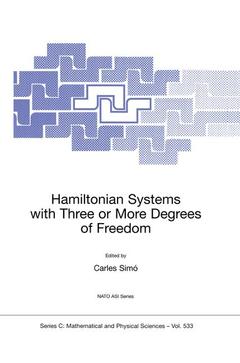Description
Hamiltonian Systems with Three or More Degrees of Freedom, 1999
Nato Science Series C: Series, Vol. 533
Coordinator: Simó Carles
Language: English
Publication date: 11-2012
658 p. · 16x24 cm · Paperback
658 p. · 16x24 cm · Paperback
Description
/li>Contents
/li>
A survey of current knowledge about Hamiltonian systems with three or more degrees of freedom and related topics. The Hamiltonian systems appearing in most of the applications are non-integrable. Hence methods to prove non-integrability results are presented and the different meaning attributed to non-integrability are discussed. For systems near an integrable one, it can be shown that, under suitable conditions, some parts of the integrable structure, most of the invariant tori, survive. Many of the papers discuss near-integrable systems.
From a topological point of view, some singularities must appear in different problems, either caustics, geodesics, moving wavefronts, etc. This is also related to singularities in the projections of invariant objects, and can be used as a signature of these objects. Hyperbolic dynamics appear as a source on unpredictable behaviour and several mechanisms of hyperbolicity are presented. The destruction of tori leads to Aubrey-Mather objects, and this is touched on for a related class of systems. Examples without periodic orbits are constructed, against a classical conjecture.
Other topics concern higher dimensional systems, either finite (networks and localised vibrations on them) or infinite, like the quasiperiodic Schrödinger operator or nonlinear hyperbolic PDE displaying quasiperiodic solutions.
Most of the applications presented concern celestial mechanics problems, like the asteroid problem, the design of spacecraft orbits, and methods to compute periodic solutions.
From a topological point of view, some singularities must appear in different problems, either caustics, geodesics, moving wavefronts, etc. This is also related to singularities in the projections of invariant objects, and can be used as a signature of these objects. Hyperbolic dynamics appear as a source on unpredictable behaviour and several mechanisms of hyperbolicity are presented. The destruction of tori leads to Aubrey-Mather objects, and this is touched on for a related class of systems. Examples without periodic orbits are constructed, against a classical conjecture.
Other topics concern higher dimensional systems, either finite (networks and localised vibrations on them) or infinite, like the quasiperiodic Schrödinger operator or nonlinear hyperbolic PDE displaying quasiperiodic solutions.
Most of the applications presented concern celestial mechanics problems, like the asteroid problem, the design of spacecraft orbits, and methods to compute periodic solutions.
Preface. List of Participants. Lectures. Contributions. List of Authors. Subject Index. Lectures. Inflection points, extatic points and curve shortening; S. Angenent. Topologically necessary singularities on moving wavefronts and caustics; V.I. Arnold. Heteroclinic chains of skew product Hamiltonian systems; S.V. Bolotin. Order and chaos in 3-D systems; G. Contopoulos, et al. Splitting of separatrices in Hamiltonian systems and symplectic maps; A. Delshams, et al. On the discrete one-dimensional quasi-periodic Schrödinger equation and other smooth quasi-periodic skew products; L.H. Eliasson. Lindstedt series and Kolmogorov theorem; G. Gallavotti. A classical self-contained proof of Kolmogorov's theorem on invariant tori; A. Giorgilli, U. Locatelli. Dynamical Stability in Lagrangian Systems; P. Boyland, C. Golé. The origin of chaotic behaviour in the Kirkwood gaps; J. Henrard. Examples of compact hypersurfaces in R2p, 2p >= 6, with no periodic orbits; M. Herman. Hamiltonian systems with three degrees of freedom and Hydrodynamics; V.V. Kozlov. Introduction to frequency map analysis; J. Laskar. Lindstedt series for lower dimensional tori; A. Jorba, et al. Arnold diffusion; a compendium of remarks and questions; P. Lochak. Old and new applications of KAM theory; J. Moser. On adiabatic invariance in two-frequency systems; A. Neishtadt. The method of rational approximations: theory and applications; J. Seimenis. Dynamical systems methods for space missions on a vicinity of collinear libration points; C. Simó. A mechanism of ergodicity in standard-like maps; Ya. G. Sinai. Continuous averaging in Hamiltonian systems; D.V. Treschev. Phase Space Geometry and Dynamics Associatedwith the 1:2:2 Resonance; S. Wiggins. From singular point analysis to rigorous results on integrability: A dream of S. Kowalevskaya; H. Yoshida. Contributions. Time singularities for polynomial Hamiltonians with analytic time dependence; S. Abenda. Numerical study of turbulence in N-body Hamilton-ian systems with long range force I. Relaxation; M. Antoni, et al. Phase space structures in 3 and 4 degrees of freedom: Application to chemical reactions; K.M. Atkins, M. Hutson. Modulated diffusion for symplectic maps; A. Bazzani, F. Brini. On the Jeans-Landau-Teller approximation for adiabatic invariants; G. Benettin. Periodic orbits and quantum mechanics of molecular Hamiltonian systems; R.M. Benito, F. Borondo. Chaos in atom-surface collisions; F. Borondo, et al. On the non-integrability of the Mixmaster Universe model; T. Bountis, L. Drossos. Branching of solutions as obstruction to the existence of a meromorphic integral in many-dimensional systems; S.A. Dovbysh. The energy surfaces of the Kovalevskaya-top; H.R. Dullin. Filling rates for linear flow on the torus: recent progress and applications; H.S. Dumas. Invariant spectra of orbits in multidimensional symplectic maps; N. Voglis, et al. On the convergence of formal series containing small divisors; L. Chierchia, C. Falcolini. Systems with an invariant measure on Lie groups; Y.N. Fedorov. Stochasticity of the 2/1 asteroidal resonance: a symplectic mapping approach; S. Ferraz-Mello. On perturbed oscillators in 1-1-1 resonance: critical inclination in the 3D Hénon-Heiles potential; S. Ferrer, et al. Splitting of separatrices for (fast) quasiperiodic forcing; A. Delshams, et al. A possible mechanism for the KAM tori breakdown; G. Gentile, V.
© 2024 LAVOISIER S.A.S.




